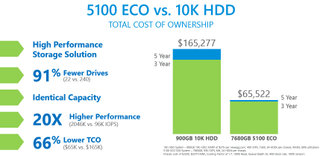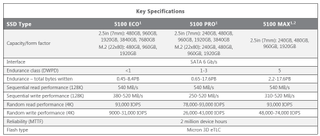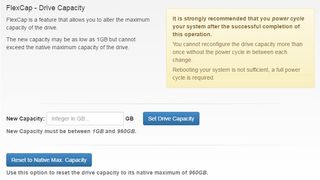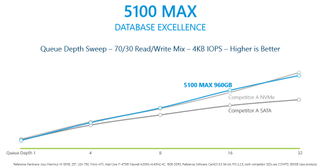Micron Infuses 8TB 5100 Series SSDs With 3D TLC NAND

We expect NVMe and SAS SSDs to be blazing fast, but the SATA SSDs that comprise almost 80% of the data center tend to be the slow-but-sure type that gets the job done at a low price point. Micron is shaking things up a bit with its latest 5100 Series SSDs, which not only tip the scales with 8TB of storage, but also bring a blistering 74,000 random write IOPS to bear. This easily beats Samsung, the industry Goliath at this point, which musters a comparatively unimpressive 27,825 IOPS with its SM863, and it also beats out Micron's own previous-generation M510DC SSDs, which provided 23,528 IOPS.

Other considerations, such as capacity and cost, are often more important than performance. The Micron 5100 Series marks the debut of its 3D TLC NAND in the enterprise SATA segment, which brings about the benefits of reduced cost and increased density. Micron delivers on the density front with up to 8TB in the standard 2.5" form factor (7mm Z-height), although the 8TB model isn't available through retail at launch. Micron's 3D TLC NAND also enables a lower price point than competing SSDs, with prices ranging from $0.45 to $0.75 per GB, and (of course) lower pricing for volume sales. SSDs have already supplanted 15K HDDs for the majority of workloads, and Micron's key objective with the 5100 Series is to offer a lower total cost of ownership (TCO) than 10K HDDs.

The 5100 Series launches in three variants with differing amounts of capacity and endurance. The Eco comes with less than 1 DWPD (Drive Writes Per Day) of endurance, whereas the Pro offers 1-3 DWPD, and the Max provides 5 DWPD. The 5100 Series comes in both 2.5" and M.2 form factors, with the exception of the 2.5"-only Max. The M.2 models employ the SATA interface.

Micron based all three of the models upon the same underlying Marvell Dean controllers and 3D TLC NAND, but Micron varied the performance and endurance through overprovisioning adjustments. The single architecture allows OEMs and hyperscale customers to qualify one drive design that meets all three of the primary use cases. Micron is also introducing its new FlexPro firmware, which interacts with the company's Storage Executive management software, to allow users to change the endurance and performance profile of the SSDs. The new FlexCap feature allows users to manually adjust the overprovisioning, which allows users to adjust an Eco to the Pro or Max level, and likewise the Pro model can shift into the same performance and endurance of the Max.

The enterprise SSDs offer features we expect, such as power loss protection and encryption options. Most consumer TLC SSDs employ SLC cache layers, but Micron doesn't use the technique with the 5100 Series. Micron focused on improved performance consistency (which doesn't mesh well with SLC buffers) and higher mixed workload performance for the new series and claimed that it can match the mixed workload performance of some mid-range NVMe SSDs.
The new line of Micron SSDs appears impressive, and Micron has historically been very conservative with its performance specifications, so the SSDs likely live up to the company's claims. The mix of performance and endurance, not to mention capacity, put Micron on a very competitive footing with other vendors. Samsung (and others) have high-capacity SSDs in the lucrative SAS segment, but do not offer nearly as much capacity in the high-volume SATA segment. Micron expects to be shipping more 3D NAND than 2D NAND by the end of the year, and the release of new 3D NAND-powered models indicates that the 3D transition across its product stack is also well underway.
Stay on the Cutting Edge
Join the experts who read Tom's Hardware for the inside track on enthusiast PC tech news — and have for over 25 years. We'll send breaking news and in-depth reviews of CPUs, GPUs, AI, maker hardware and more straight to your inbox.

Paul Alcorn is the Managing Editor: News and Emerging Tech for Tom's Hardware US. He also writes news and reviews on CPUs, storage, and enterprise hardware.
-
2Be_or_Not2Be So is the article saying an "ECO" can be changed to a "Pro" simply by changing the over-provisioning? Or is it saying the amount of over-provisioning can be increased to what the next higher model would have - like going from 8% OP to 12 or 15%?Reply -
PaulAlcorn Reply18964532 said:So is the article saying an "ECO" can be changed to a "Pro" simply by changing the over-provisioning? Or is it saying the amount of over-provisioning can be increased to what the next higher model would have - like going from 8% OP to 12 or 15%?
The only difference between the various models is overprovisioning, so yes, changing the percentage allows users to move up to the same performance and endurance of the higher SKU.
-
SSDbuilder One can adjust an ECO drive to have the same performance as a MAX drive, by increasing the overprovision. However, as one raises the OP, one must also lower the user capacity. a 480G ECO will not run like a 480GB MAX drive, unless you make it a350GB driveReply -
SSDbuilder Yes, an ECO drive can be made to run like a MAX drive, but nothing comes for free. To get MAX like performance from an ECO drive, the over provision must be increased, so the user capacity will go down. For example, to run like it's MAX counterpart, a 480GB ECO would have to be redefined to have about 350GB user capacity.Reply
Most Popular




